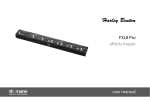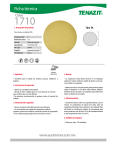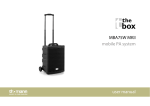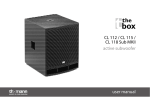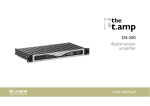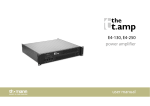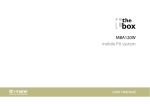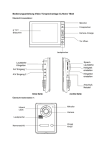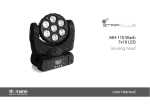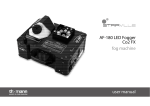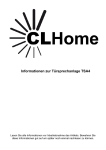Download Manual
Transcript
TSA 4-700, TSA 1400, TSA 2200, TSA 4000, TSA 4-300, TSA 4-1300 power amplifier user manual Musikhaus Thomann e. K. Treppendorf 30 96138 Burgebrach Germany Telephone: +49 (0) 9546 9223-0 E-mail: [email protected] Internet: www.thomann.de 04.12.2014, ID: 218912, 218913, 218915, 287602, 325986, ... (V2) Table of contents Table of contents 1 General information................................................................................................................................. 1.1 Further information........................................................................................................................... 1.2 Notational conventions.................................................................................................................... 1.3 Symbols and signal words............................................................................................................... 2 Safety notes.................................................................................................................................................. 8 3 Features....................................................................................................................................................... 13 4 Installation and starting up................................................................................................................ 14 5 Connections and operating elements........................................................................................... 15 6 Current consumption............................................................................................................................ 31 7 Technical specifications....................................................................................................................... 35 8 Plug and connection assignment.................................................................................................... 47 9 Cleaning....................................................................................................................................................... 50 10 Protecting the environment.............................................................................................................. 51 TSA 4-700, TSA 1400, TSA 2200,TSA 4000, TSA 4-300, TSA 4-1300 3 4 5 6 6 General information 1 General information This manual contains important instructions for the safe operation of the unit. Read and follow the safety instructions and all other instructions. Keep the manual for future reference. Make sure that it is available to all those using the device. If you sell the unit please make sure that the buyer also receives this manual. Our products are subject to a process of continuous development. Thus, they are subject to change. power amplifier 4 General information 1.1 Further information On our website (www.thomann.de) you will find lots of further information and details on the following points: Download This manual is also available as PDF file for you to download. Keyword search Use the search function in the electronic version to find the topics of interest for you quickly. Online guides Our online guides provide detailed information on technical basics and terms. Personal consultation For personal consultation please contact our technical hotline. Service If you have any problems with the device the customer service will gladly assist you. TSA 4-700, TSA 1400, TSA 2200,TSA 4000, TSA 4-300, TSA 4-1300 5 General information 1.2 Notational conventions This manual uses the following notational conventions: Letterings The letterings for connectors and controls are marked by square brackets and italics. Examples: [VOLUME] control, [Mono] button. Cross-references References to other locations in this manual are identified by an arrow and the specified page number. In the electronic version of the manual, you can click the cross-reference to jump to the specified location. Example: See Ä ‘Cross-references’ on page 6. 1.3 Symbols and signal words In this section you will find an overview of the meaning of symbols and signal words that are used in this manual. power amplifier 6 General information Signal word Meaning DANGER! This combination of symbol and signal word indicates an immediate dangerous situation that will result in death or serious injury if it is not avoided. CAUTION! This combination of symbol and signal word indicates a pos‐ sible dangerous situation that can result in minor injury if it is not avoided. NOTICE! This combination of symbol and signal word indicates a pos‐ sible dangerous situation that can result in material and environmental damage if it is not avoided. Warning signs Type of danger Warning – high-voltage. Warning – danger zone. TSA 4-700, TSA 1400, TSA 2200,TSA 4000, TSA 4-300, TSA 4-1300 7 Safety notes 2 Safety notes Intended use This device amplifies electric audio frequency signals to operate passive speakers. Use the device only as described in this user manual. Any other use or use under other operating con‐ ditions is considered to be improper and may result in personal injury or property damage. No liability will be assumed for damages resulting from improper use. This device may be used only by persons with sufficient physical, sensorial, and intellectual abilities and having corresponding knowledge and experience. Other persons may use this device only if they are supervised or instructed by a person who is responsible for their safety. Safety DANGER! Danger for children Ensure that plastic bags, packaging, etc. are disposed of properly and are not within reach of babies and young children. Choking hazard! Ensure that children do not detach any small parts (e.g. knobs or the like) from the unit. They could swallow the pieces and choke! Never let children unattended use electrical devices. power amplifier 8 Safety notes DANGER! Electric shock caused by high voltages inside Within the device there are areas where high voltages may be present. Never remove any covers. There are no user-serviceable parts inside. DANGER! Electric shock caused by short-circuit Always use proper ready-made insulated mains cabling (power cord) with a pro‐ tective contact plug. Do not modify the mains cable or the plug. Failure to do so could result in electric shock/death or fire. If in doubt, seek advice from a regis‐ tered electrician. TSA 4-700, TSA 1400, TSA 2200,TSA 4000, TSA 4-300, TSA 4-1300 9 Safety notes CAUTION! Possible hearing damage The device can produce volume levels that may cause temporary or permanent hearing impairment. Over an extended period of time, even levels that seem to be uncritical can cause hearing damage. Decrease the volume level immediately if you experience ringing in your ears or hearing impairment. If this is not possible, keep a greater distance or use suffi‐ cient ear protectors. NOTICE! Risk of fire Do not cover the device nor any ventilation slots. Do not place the device near any direct heat source. Keep the device away from naked flames. power amplifier 10 Safety notes NOTICE! Operating conditions This device has been designed for indoor use only. To prevent damage, never expose the device to any liquid or moisture. Avoid direct sunlight, heavy dirt, and strong vibrations. NOTICE! Power supply Before connecting the device, ensure that the input voltage (AC outlet) matches the voltage rating of the device and that the AC outlet is protected by a residual current circuit breaker. Failure to do so could result in damage to the device and possibly injure the user. Unplug the device before electrical storms occur and when it is unused for long periods of time to reduce the risk of electric shock or fire. TSA 4-700, TSA 1400, TSA 2200,TSA 4000, TSA 4-300, TSA 4-1300 11 Safety notes NOTICE! Magnetic fields The device generates strong magnetic fields that can interfere with the function of poorly shielded devices. The strongest magnetic fields are directly above and below the power amplifier. Therefore, never place sensitive devices such as preamplifiers, radio transmission systems, or tape decks directly above or below the power amplifier. When installing the power amplifier into a rack, you should place it in the lowest position, and further equipment such as pre-amplifiers in the highest position. power amplifier 12 Features 3 Features Common features of all models described: integrated switching power supply XLR inputs lockable NL4 output sockets protective circuits – audio limiter – thermal protection – short circuit protection n 19" rack-mountable (2 RU) n n n n Find device-specific features here Ä Chapter 5 ‘Connections and operating elements’ on page 15, Ä Chapter 6 ‘Current consumption’ on page 31 and Ä Chapter 7 ‘Technical specifications’ on page 35. TSA 4-700, TSA 1400, TSA 2200,TSA 4000, TSA 4-300, TSA 4-1300 13 Installation and starting up 4 Installation and starting up Unpack and carefully check that there is no transportation damage before using the unit. Keep the equipment packaging. To fully protect the device against vibration, dust and moisture during transportation or storage use the original packaging or your own packaging material suitable for transport or storage, respectively. Establish all connections as long as the unit is switched off. Use the shortest possible highquality cables for all connections. power amplifier 14 Connections and operating elements 5 Connections and operating elements Front panel TSA 4-700 TSA 4-700, TSA 1400, TSA 2200,TSA 4000, TSA 4-300, TSA 4-1300 15 Connections and operating elements 1 [POWER] Main switch to turn the device on and off. 2 LED indicators for [CH-A] … [CH-D] These LEDs indicate that the unit is operational ([Power]), the input signal level ([Signal] / –20 / –15 / –10 / –5), channel overload ([Clip]) and a fault condition ([Fault]). 3 [CH-A] … [CH-D] Input gain controls for channels A to D. The LED [Power] lights permanently during operation. The LEDs [Signal] / [–20] / [–15] / [–10] / [–5] respond to the input signal. If any of these LEDs are lit without an input signal is present disconnect the speakers from the amplifier and turn the input gain controls of channels A to D down to minimum. If the LEDs will still light, the device must be checked by an authorized service workshop. power amplifier 16 Connections and operating elements Rear panel TSA 4-700 TSA 4-700, TSA 1400, TSA 2200,TSA 4000, TSA 4-300, TSA 4-1300 17 Connections and operating elements 4 IEC chassis plug for the power supply. 5 [OUTPUT CH-A] … [OUTPUT CH-D] Signal outputs, designed as lockable NL4 chassis socket to connect speakers. 6, 9, 10, 11 [INPUT CH-A] … [INPUT CH-D] Signal input channels, designed as XLR socket pair (input / output) to loop the audio signal to other devices. 7 Push-button [Stereo | Bridge] Switch for operating modes ‘Stereo’ (channels operate independently of each other) and ‘Bridge’ (two channels are interconnected to form one channel with double output). 8 Push-button [Lift | Ground] Use the Ground / Lift switch to separate the connection between the earth pin of the device and the unit's signal ground to prevent ground loops: n ‘Lift’ position (not pressed): no connection n ‘Ground’ position (pressed): earth pin and signal ground are electrically connected power amplifier 18 Connections and operating elements Front panel TSA 1400, 2200, 4000 TSA 4-700, TSA 1400, TSA 2200,TSA 4000, TSA 4-300, TSA 4-1300 19 Connections and operating elements 1 [POWER] Main switch to turn the device on and off. 2 LED indicators [CH-A], [CH-B] These LEDs indicate that the unit is operational ([Power]), the input signal level ([Signal] / –20 / –15 / –10 / –5), channel overload ([Clip]) and a fault condition ([Fault]). 3 [CH-A], [CH-B] Input gain controls for channels A and B. The LED [Power] lights permanently during operation. The LEDs [Signal] / [–20] / [–15] / [–10] / [–5] respond to the input signal. If any of these LEDs are lit without an input signal is present disconnect the speakers from the amplifier and turn the input gain controls of channels A and B down to minimum. If the LEDs will still light, the device must be checked by an authorized service workshop. power amplifier 20 Connections and operating elements Rear panel TSA 1400, 2200, 4000 TSA 4-700, TSA 1400, TSA 2200,TSA 4000, TSA 4-300, TSA 4-1300 21 Connections and operating elements 4 IEC chassis plug for the power supply. 5 [OUTPUT CH-A], [OUTPUT CH-B] Signal outputs, designed as lockable NL4 chassis socket to connect speakers. 6, 9 [INPUT CH-A], [INPUT CH-B] Signal input channels, designed as XLR socket pair (input / output) to loop the audio signal to other devices. 7 Push-button [Stereo | Bridge] Switch for operating modes ‘Stereo’ (channels operate independently of each other) and ‘Bridge’ (two channels are interconnected to form one channel with double output). 8 Push-button [Lift | Ground] Use the Ground / Lift switch to separate the connection between the earth pin of the device and the unit's signal ground to prevent ground loops: n ‘Lift’ position (not pressed): no connection n ‘Ground’ position (pressed): earth pin and signal ground are electrically connected power amplifier 22 Connections and operating elements Front panel TSA 4-300 TSA 4-700, TSA 1400, TSA 2200,TSA 4000, TSA 4-300, TSA 4-1300 23 Connections and operating elements 1 [POWER] Main switch to turn the device on and off. 2 LED indicators [CH-A] … [CH-D] These LEDs indicate that the unit is operational ([Power]), the input signal level ([Signal] / –20 / –15 / –10 / –5), channel overload ([Clip]) and a fault condition ([Fault]). 3 [CH-A] … [CH-D] Input gain controls for channels A to D. The LED [Power] lights permanently during operation. The LEDs [Signal] / [–20] / [–15] / [–10] / [–5] respond to the input signal. If any of these LEDs are lit without an input signal is present disconnect the speakers from the amplifier and turn the input gain controls of channels A to D down to minimum. If the LEDs will still light, the device must be checked by an authorized service workshop. power amplifier 24 Connections and operating elements Front panel TSA 4-1300 TSA 4-700, TSA 1400, TSA 2200,TSA 4000, TSA 4-300, TSA 4-1300 25 Connections and operating elements 1 [POWER] Main switch to turn the device on and off. 2 LED indicators [CH-A] … [CH-D] These LEDs indicate that the unit is operational ([Power]), the input signal level ([Signal] / –20 / –15 / –10 / –5), channel overload ([Clip]) and a fault condition ([Fault]). 3 [CH-A] … [CH-D] Input gain controls for channels A to D. The LED [Power] lights permanently during operation. The LEDs [Signal] / [–20] / [–15] / [–10] / [–5] respond to the input signal. If any of these LEDs are lit without an input signal is present disconnect the speakers from the amplifier and turn the input gain controls of channels A to D down to minimum. If the LEDs will still light, the device must be checked by an authorized service workshop. power amplifier 26 Connections and operating elements Rear panel TSA 4-300, TSA 4-1300 TSA 4-700, TSA 1400, TSA 2200,TSA 4000, TSA 4-300, TSA 4-1300 27 Connections and operating elements 4 IEC chassis plug for the power supply. 5 [RESET] Push-button to reset the unit, for example, after the built-in automatic fuse has tripped. 6 [OUTPUT CH-A] … [OUTPUT CH-D] Signal outputs, designed as lockable NL4 chassis socket to connect speakers. 7 [INPUT 1] … [INPUT 4] XLR signal input sockets. 8 [A] Slide switch; determines how the input signals 1 and 2 are processed. In the upper switch position, the signals are fed separately to the power amps. In the lower switch position, the signals are added and fed as a mono sum signal to the power amps. The connection of the power amps is set by the push-button (11). 9 [B] Slide switch; determines how the input signals 2 and 3 are processed. In the upper switch position, the signals are fed separately to the power amps. In the lower switch position, the signals are added and fed as a mono sum signal to the power amps. power amplifier 28 Connections and operating elements 10 [C] Slide switch; determines how the input signals 3 and 4 are processed. In the upper switch position, the signals are fed separately to the power amps. In the lower switch position, the signals are added and fed as a mono sum signal to the power amps. The connection of the power amps is set by the push button (13). 11 Push-button for switching the operating mode of the power amps for the output channels A and B. n Push-button not pressed: Input signals 1 and 2 (connection depends on the position of switch [A] (8)) are being amplified in ‘stereo’ mode and separately fed to outputs A and B. The volume for output A and output B can be controlled separately with the controls for channel A or B (3). Wiring of the NL4 output sockets: Plus terminal = 1+, minus terminal = 1–. n Push-button is pressed: Both power amps operate in ‘Bridge’ mode like one power amplifier with double output power. Input signals 1 and 2 (connection depends on the position of switch [A] (8)) are being amplified. The output signal is present only at output A, the volume is controlled by the control for channel A (3). Wiring of the NL4 output sockets: Plus terminal = 1+, minus terminal = 2+. TSA 4-700, TSA 1400, TSA 2200,TSA 4000, TSA 4-300, TSA 4-1300 29 Connections and operating elements 12 The input sensitivity at which the amplifier is delivering its full rated power, can be set with this push-button between 0.775 VRMS (not pressed) and 1.4 VRMS (pressed). 13 Push-button for switching the operating mode of the power amps for the output channels C and D. n Push-button not pressed: Input signals 3 and 4 (connection depends on the position of switch [C] (10)) are being amplified in ‘stereo’ mode and separately fed to outputs C and D. The volume for output C and output D can be controlled separately with the controls for channel C or D (3). Wiring of the NL4 output sockets: Plus terminal = 1+, minus terminal = 1–. n Push-button is pushed: Both power amps operate in ‘Bridge’ mode like one power amplifier with double output power. Input signals 3 and 4 (connection depends on the position of switch [C] (8)) are being amplified. The output signal is present only at output C, the volume is controlled by the control for channel C (3). Wiring of the NL4 output sockets: Plus terminal = 1+, minus terminal = 2+. power amplifier 30 Current consumption 6 Current consumption The following table contains information on the typical current consumption depending on the output power level (root mean square value ARMS). All values refer to a supply voltage of 220 V. With a supply voltage of 230 V the data must be multiplied by factor 0.96, with 120 V by factor 1,83 and with 100 V by factor 2.2. TSA 4-700 Load 1/8 power (pink noise) 1/3 power (pink noise) Full power (sine wave) (4 ×) 8 Ω 400 W / 3.1 A 860 W / 5.8 A 1400 W / 9.5 A (4 ×) 4 Ω 650 W / 4.4 A 1500 W / 9.8 A 2450 W / 15.4 A (4 ×) 2 Ω 950 W / 6.4 A 1800 W / 11.6 A 3100 W / 20 A (2 ×) 8 Ω, bridged 620 W / 4.3 A 2450 W / 15 A 2450 W / 15 A (2 ×) 4 Ω, bridged 870 W / 6.1 A 3300 W / 19.5 A 3300 W / 19.5 A TSA 4-700, TSA 1400, TSA 2200,TSA 4000, TSA 4-300, TSA 4-1300 31 Current consumption TSA 1400 Load 1/8 power (pink noise) 1/3 power (pink noise) Full power (sine wave) (2 ×) 8 Ω 330 W / 1.93 A 734 W / 4.4 A 1400 W / 7.74 A (2 ×) 4 Ω 480 W / 2.86 A 1200 W / 6.9 A 2300 W / 12.2 A (2 ×) 2 Ω 700 W / 4.1 A 1313 W / 7.2 A 3345 W / 17.3 A 8 Ω, bridged 500 W / 3.0 A 1200 W / 6.9 A 2300 W / 12.4 A 4 Ω, bridged 984 W / 5.4 A 2690 W / 14.2 A 3310 W / 17.2 A Load 1/8 power (pink noise) 1/3 power (pink noise) Full power (sine wave) (2 ×) 8 Ω 260 W / 1.69 A 400 W / 2.73 A 1700 W / 9.5 A (2 ×) 4 Ω 680 W / 4.0 A 1180 W / 6.5 A 2800 W / 14.97 A TSA 2200 power amplifier 32 Current consumption Load 1/8 power (pink noise) 1/3 power (pink noise) Full power (sine wave) (2 ×) 2 Ω 850 W / 5.0 A 1800 W / 9.8 A 4200 W / 21 A 8 Ω, bridged 680 W / 4.1 A 1200 W / 6.8 A 2850 W / 15.2 A 4 Ω, bridged 820 W / 4.5 A 1900 W / 10.1 A 4600 W / 23 A Load 1/8 power (pink noise) 1/3 power (pink noise) Full power (sine wave) (2 ×) 8 Ω 475 W / 3.7 A 974 W / 6.8 A 2732 W / 17 A (2 ×) 4 Ω 708 W / 5.1 A 1640 W / 11 A 4018 W / 26 A (2 ×) 2 Ω – – – 8 Ω, bridged 677 W / 5 A 1520 W / 10.2 A 4346 W / 27 A 4 Ω, bridged – – – TSA 4000 TSA 4-700, TSA 1400, TSA 2200,TSA 4000, TSA 4-300, TSA 4-1300 33 Current consumption TSA4-300 Load 1/8 power (pink noise) 1/3 power (pink noise) Full power (sine wave) (4 ×) 8 Ω 420 W / 3.2 A 1050 W / 7.5 A 1960 W / 13.6 A (4 ×) 4 Ω 700 W / 5.2 A 1810 W / 12.5 A 2250 W / 21.7 A 2 ×8 Ω, bridged 706 W / 5.6 A 1847 W / 13.1 A 3438 W / 22.8 A Load 1/8 power (pink noise) 1/3 power (pink noise) Full power (sine wave) (4 ×) 8 Ω 1050 W / 7.5 A 2920 W / 18.7 A 6503 W / 39.4 A (4 ×) 4 Ω 1580 W / 10.7 A 4230 W / 25.8 A 9410 W / 53 A 2 ×8 Ω, bridged 1631 W / 11.8 A 4450 W / 28.7 A 9020 W / 52.4 A TSA4-1300 power amplifier 34 Technical specifications 7 Technical specifications TSA 4-700 Load impedance 8W 4W 2W Rated output power (THD ≤1 %, 1 kHz) 4 × 490 W 4 × 810 W 4 × 930 W Max. output power ‘bridged’ (THD ≤1 %, 1 kHz) 2 × 1600 W 2 × 1800 W – Max. voltage swing (RMS) (THD ≤1 %, 1 kHz) 62.6 V Slew rate (1 kHz) 38 V/ms THD < 0.1 % IMD-SMPTE (60 Hz, 7 kHz) < 0.1 % DIM 30 (3.15 kHz, 15 kHz) < 0.1 % Crosstalk (ref. 1 kHz, 10 % rated power) > 70 dB Frequency response (ref. 1 kHz) 20 Hz … 20 kHz (0 – 2 dB) TSA 4-700, TSA 1400, TSA 2200,TSA 4000, TSA 4-300, TSA 4-1300 35 Technical specifications Input impedance (20 Hz - 20 kHz, balanced) 20 kW (balanced) 10 kW (unbalanced) Input sensitivity (rated power output, 1 kHz) 1V Damping factor (100 Hz / 1 kHz, 8 W) > 400 Voltage amplification 38,4 dB Signal-to-noise ratio 105 dB (A-weighted) Protective circuits Temperature, short circuit, limiter Cooling front to rear Operating supply voltage AC 230 V Power consumption see Ä Chapter 6 ‘Current consumption’ on page 31 Dimensions (W × H × D) 488 mm × 97 mm × 370 mm Weight 10.7 kg , 50/60 Hz power amplifier 36 Technical specifications TSA 1400 Load impedance 8W 4W 2W Rated output power (THD ≤1 %, 1 kHz) 2 × 450 W 2 × 670 W 2 × 800 W Max. output power ‘bridged’ (THD ≤1 %, 1 kHz) 1 × 1380 W 1 × 1600 W – Max. voltage swing (RMS) (THD ≤1 %, 1 kHz) 60 V Slew rate (1 kHz) 35 V/ms THD < 0.1 % IMD-SMPTE (60 Hz, 7 kHz) < 0.1 % DIM 30 (3.15 kHz, 15 kHz) < 0.1 % Crosstalk (ref. 1 kHz, 10 % rated power) > 70 dB Frequency response (ref. 1 kHz) 20 Hz … 20 kHz (0 – 2 dB) TSA 4-700, TSA 1400, TSA 2200,TSA 4000, TSA 4-300, TSA 4-1300 37 Technical specifications Input impedance (20 Hz - 20 kHz, balanced) 20 kW (balanced) 10 kW (unbalanced) Input sensitivity (rated power output 1 kHz) 1V Damping factor (100 Hz / 1 kHz, 8 W) > 400 Voltage amplification 38,3 dB Signal-to-noise ratio 105 dB (A-weighted) Protective circuits Temperature, short circuit, limiter Cooling front to rear Operating supply voltage AC 230 V Power consumption see Ä Chapter 6 ‘Current consumption’ on page 31 Dimensions (W × H × D) 484 mm × 97 mm × 370 mm Weight 10.6 kg , 50/60 Hz power amplifier 38 Technical specifications TSA 2200 Load impedance 8W 4W 2W Rated output power (THD ≤1 %, 1 kHz) 2 × 590 W 2 × 910 W 2 × 1200 W Max. output power ‘bridged’ (THD ≤1 %, 1 kHz) 1 × 1800 W 1 × 2400 W – Max. voltage swing (RMS) (THD ≤1 %, 1 kHz) 68.7 V Slew rate (1 kHz) 41 V/ms THD < 0.1 % IMD-SMPTE (60 Hz, 7 kHz) < 0.1 % DIM 30 (3.15 kHz, 15 kHz) < 0.1 % Crosstalk (ref. 1 kHz, 10 % rated power) > 70 dB Frequency response (ref. 1 kHz) 20 Hz … 20 kHz (0 – 2 dB) TSA 4-700, TSA 1400, TSA 2200,TSA 4000, TSA 4-300, TSA 4-1300 39 Technical specifications Input impedance (20 Hz - 20 kHz, balanced) 20 kW (balanced) 10 kW (unbalanced) Input sensitivity (rated power output 1 kHz) 1V Damping factor (100 Hz / 1 kHz, 8 W) > 400 Voltage amplification 39,8 dB Signal-to-noise ratio 105 dB (A-weighted) Protective circuits Temperature, short circuit, limiter Cooling front to rear Operating supply voltage AC 230 V Power consumption see Ä Chapter 6 ‘Current consumption’ on page 31 Dimensions (W × H × D) 485 mm × 97 mm × 370 mm Weight 10.4 kg , 50/60 Hz power amplifier 40 Technical specifications TSA 4-300 Load impedance 8Ω 4Ω Rated output power (THD ≤1 %, 1 kHz) 4 × 350 W 4 × 550 Max. output power ‘bridged’ (THD ≤ 1 %, 1 kHz) 2 × 1000 W – THD < 0.5 % IMD-SMPTE (60 Hz, 7 kHz) ≤ 0.35 % Crosstalk (at 1 kHz) –75 dB (at 20 kHz) –58 dB Frequency response (1 W) 20 Hz … 20 kHz (0 – 1 dB) Input impedance 20 kΩ (balanced) 10 kΩ (unbalanced) Input sensitivity (rated power output 1 kHz) 0.775 V / 1.4 V, (switchable) Damping factor (10 Hz / 400 Hz, 8 W) > 200 TSA 4-700, TSA 1400, TSA 2200,TSA 4000, TSA 4-300, TSA 4-1300 41 Technical specifications Voltage amplification 35.3 dB Signal-to-noise ratio > 100 dB (A-weighted) Protection circuits against short circuit, missing load, cracking when turning on and off, radio interference Cooling Internal heat dissipation with forced ventilation through con‐ trolled fan, overheating protection Ventilation front to rear Operating supply voltage AC 230 V Power consumption see Ä Chapter 6 ‘Current consumption’ on page 31 Dimensions (W × H × D) 482 mm × 88 mm × 227 mm Weight 7.5 kg power amplifier 42 , 50/60 Hz Technical specifications TSA 4-1300 Load impedance 8Ω 4Ω Rated output power (THD ≤1 %, 1 kHz) 4 × 1220 W 4 × 1670 Max. output power ‘bridged’ (THD ≤1 %, 1 kHz) 2 × 4000 W – THD < 0.5 % IMD-SMPTE (60 Hz, 7 kHz) ≤ 0.35 % Crosstalk (at 1 kHz) –75 dB (at 20 kHz) –58 dB Frequency response (1 W) 20 Hz … 20 kHz (0 – 1 dB) Input impedance 20 kΩ (balanced) 10 kΩ (unbalanced) Input sensitivity (rated power output 1 kHz) 0.775 V / 1.4 V, (switchable) Damping factor (10 Hz / 400 Hz, 8 W) > 200 TSA 4-700, TSA 1400, TSA 2200,TSA 4000, TSA 4-300, TSA 4-1300 43 Technical specifications Voltage amplification 37.8 dB Signal-to-noise ratio > 100 dB (A-weighted) Protection circuits against short circuit, missing load, cracking when turning on and off, radio interference Cooling Internal heat dissipation with forced ventilation through con‐ trolled fan, overheating protection Ventilation front to rear Operating supply voltage AC 230 V Power consumption see Ä Chapter 6 ‘Current consumption’ on page 31 Dimensions (W × H × D) 482 mm × 88 mm × 380 mm Weight 12.5 kg power amplifier 44 , 50/60 Hz Technical specifications TSA 4000 Load impedance 8W 4W 2W Nominal power output (THD ≤1 %, 1 kHz) 2 × 1000 W 2 × 1500 – Max. power output, bridged mode (THD ≤1 %, 1 kHz) 1 × 2865 W – – Max. voltage increase (RMS) (THD ≤1 %, 1 kHz) 89 V Slew rate (1 kHz) 50 V/ms Total harmonic distortion (THD) < 0,1 % IMD-SMPTE (60 Hz, 7 kHz) < 0,35 % DIM 30 (3.15 kHz, 15 kHz) < 0,35 % Crosstalk (at 1 kHz, 10 % nominal power) < –80 dB Frequency response (at 1 kHz) 20 Hz … 20 kHz (0 – 2 dB) TSA 4-700, TSA 1400, TSA 2200,TSA 4000, TSA 4-300, TSA 4-1300 45 Technical specifications Input impedance (20 Hz – 20 kHz, balanced) 20 kW (balanced) 10 kW (unbalanced) Input sensitivity (nominal power output, 1 kHz) 1V Damping factor (100 Hz / 1 kHz, 8 W) > 450 Voltage amplification 37 dB Signal-to-noise ratio (SNR) 106 dB (A-weighted) Protective circuits Thermal, short circuit, limiter Cooling from front to back Mains power supply 230 V Power consumption see Ä Chapter 6 ‘Current consumption’ on page 31 Dimensions (W × H × D) 483 × 88 × 420 mm (19.02 × 3.46 × 1.53 inches) Weight 12 kg (26.5 lbs) (AC), 50/60 Hz power amplifier 46 Plug and connection assignment 8 Plug and connection assignment Introduction This chapter will help you select the right cables and plugs to connect your valuable equip‐ ment in such a way that a perfect sound experience is ensured. Please note these advices, because especially in ‘Sound & Light’ caution is indicated: Even if a plug fits into the socket, an incorrect connection may result in a destroyed power amp, a short circuit or ‘just’ in poor transmission quality! Balanced and unbalanced trans‐ mission Unbalanced transmission is mainly used in semi-professional environment and in hifi use. Instrument cables with two conductors (one core plus shielding) are typical representatives of the unbalanced transmission. One conductor is ground and shielding while the signal is trans‐ mitted through the core. Unbalanced transmission is susceptible to electromagnetic interference, especially at low levels, such as microphone signals and when using long cables. In a professional environment, therefore, the balanced transmission is preferred, because this enables an undisturbed transmission of signals over long distances. In addition to the conduc‐ tors ‘Ground’ and ‘Signal’, in a balanced transmission a second core is added. This also transfers the signal, but phase-shifted by 180°. TSA 4-700, TSA 1400, TSA 2200,TSA 4000, TSA 4-300, TSA 4-1300 47 Plug and connection assignment Since the interference affects both cores equally, by subtracting the phase-shifted signals, the interfering signal is completely neutralized. The result is a pure signal without any noise inter‐ ference. XLR plug (balanced) 1 Ground, shielding 2 Signal (in phase, +) 3 Signal (out of phase, –) 1 Ground, shielding 2 Signal 3 Bridged to pin 1 XLR plug (unbalanced) power amplifier 48 Plug and connection assignment NL4 mounting connectors 1, + Signal 1 (in phase) 1, – Signal 1 (180 degree phase shift) 2, + Signal 2 (in phase) 2, – Signal 2 (180 degree phase shift) TSA 4-700, TSA 1400, TSA 2200,TSA 4000, TSA 4-300, TSA 4-1300 49 Cleaning 9 Cleaning Fan grids The fan grids of the device must be cleaned on a regular basis to remove dust and dirt. Before cleaning, switch off the device and disconnect AC-powered devices from the mains. Use a lintfree damp cloth for cleaning. Never use solvents or alcohol for cleaning. power amplifier 50 Protecting the environment 10 Protecting the environment Disposal of the packaging mate‐ rial For the transport and protective packaging, environmentally friendly materials have been chosen that can be supplied to normal recycling. Ensure that plastic bags, packaging, etc. are properly disposed of. Do not just dispose of these materials with your normal household waste, but make sure that they are collected for recycling. Please follow the notes and markings on the packaging. Disposal of your old device This product is subject to the European Waste Electrical and Electronic Equipment Directive (WEEE). Do not dispose with your normal household waste. Dispose of this device through an approved waste disposal firm or through your local waste facility. When discarding the device, comply with the rules and regulations that apply in your country. If in doubt, consult your local waste disposal facility. TSA 4-700, TSA 1400, TSA 2200,TSA 4000, TSA 4-300, TSA 4-1300 51 Notes power amplifier 52 Notes TSA 4-700, TSA 1400, TSA 2200,TSA 4000, TSA 4-300, TSA 4-1300 53 Notes power amplifier 54 Musikhaus Thomann e.K. · Treppendorf 30 · 96138 Burgebrach · Germany · www.thomann.de
























































